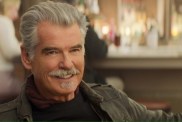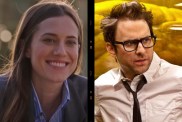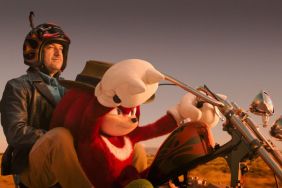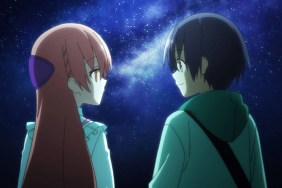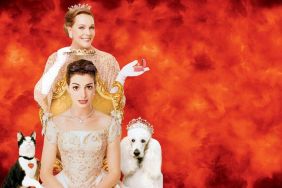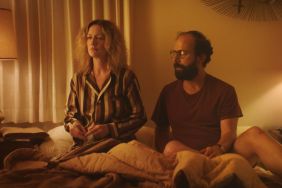In 1991, Don Hahn became the first producer nominated for an Academy Award for an animated film in the Best Picture category when Beauty and the Beast set a precedent that took eighteen years to repeat. He followed that by producing The Lion King, which became the highest grossing animated film, a record it would hold for nine years.
Obviously, there aren’t many people who know as much about Disney Animation from that groundbreaking era, so it made sense that Hahn would accumulate all the information available to him from that time, including never-before-seen home movies and collect them into Waking Sleeping Beauty, a documentary that pulls back the curtain on the regeneration of Disney Animation in the late-’80s with the release of The Little Mermaid. That would lead to a string of animated musical hits that have fed an entire new generation of Disney fans as they generated equally successful straight-to-DVD sequels and even Broadway musicals.
If you’ve ever been a fan of Disney Animation, either as a kid or now, then Waking Sleeping Beauty is a must-see documentary, retaining the spirit and magic of those films so many people love, while also taking a serious no-punches-pulled look at what was really going on behind the scenes as the Mouse House tried to pull its animation department out of a potentially devastating tailspin. At the forefront were three men with very different personalities: Roy Disney, Michael Eisner and Jeffrey Katzenberg, and Waking Sleeping Beauty is as much about their conflict as it is about the making of the movies.
There are few individuals who have been seen the evolution of Walt Disney Pictures over the last 25 years as Hahn has, which is why ComingSoon.net was thrilled to get on the phone with him last week to talk about his new doc and some of his other upcoming projects.
ComingSoon.net: Is this your first documentary, or have you been doing similar things as this over the years?
Don Hahn: I have not, this is my first documentary and I felt like I knew the story well enough to tell it. I’m not sure I’m a documentarian, but for this purpose, I am a documentarian, because I lived it and I feel like I was close enough to be able to make the movie.
CS: You’ve written a lot of books, so did you ever think about writing a book on the subject or was it just a choice of doing one or the other?
Hahn: Yeah, I never felt like I should write a book about this period because it would be a little self-serving or a little too close to it. I guess more of the kinds of books I like to write are things that share the technique and the process so that kids coming up will understand what goes into making these movies.
CS: Oddly, I wasn’t really that familiar with those Disney animated movies–it’s a long story–but it was fascinating to see the behind-the-scenes of what went into making them. I know a lot of people who love that era of Disney animation, and we’ve never really gotten that much of an inside look at the process. How did this documentary come about? Was it something you were toying around with over the years?
Hahn: Peter Schneider, who is my collaborator and produced the movie, had come up with the idea and wanted to do it for a long time. I was skeptical when he mentioned it, but the more we talked about it, it felt like it was certainly a very special time, certainly with the personalities involved, with the artists, Howard Ashman to Roy Disney and Michael Eisner and Jeffrey Katzenberg. It seemed like this is a really special time in the history of Hollywood and all of those personalities are blown apart out to the winds. But still, for one brief moment there was kinda a lot in these studios and you could point back to it and say, “This was a really interesting time and a story worth telling.”
CS: It’s kinda funny that Peter produced the movie, because there’s definitely parts of the movie where he does not come off that well. Did he realize that and just said, “I want to just do it anyway?”
Hahn: Yeah, very definitely. I think there was support from not only Peter, but from Jeffrey and all the players to be a part of it, I think mainly because enough time had passed. We knew it was a special time, but if it were earlier to that time, the wounds mighta been a little fresher. I think that was the time you could look at it with some distance and say, “Yeah, you know we had our faults and yeah, that caricature’s pretty brutal.” But you would expect to actually understand what it meant to look back twenty years and remember that time, warts and all, good, bad or indifferent.
CS: How involved was Disney in making the movie, because obviously you had to get approval from them for a lot of the footage, I’d imagine. Did they help finance the movie or were they involved in some way at all while making it?
Hahn: We went to Richard Cook, who was the head of the studio when we first started this movie. Peter and I went out to have breakfast with him and said, “We’d like to tell this story and how important the history of Disney was to preserve.” He was incredibly supportive not only in terms of finances, but calling Jeffrey Katzenberg about it saying, “Jeffrey, we want to do this story. Would you be involved? Would you talk to Don about it and give us access to the clips from the Disney library?” So without Dick’s patronage at the beginning, it wouldn’t have happened. Then luckily other people jumped on board. I think we had great support from Bob Iger, we had great support from Ed Catmull, and people in animation today just to be able to preserve this part of our history.

CS: How long ago was it that you sat down with Dick Cook to discuss this?
Hahn: Oh, it was two years ago, almost two-and-a-half years ago, we sat down with Dick and had that breakfast. It took a while to pull it together and do some budgeting and so forth, but it’s a little over two-and-a-half years.
CS: As far as the involvement of Disney and getting approval for footage, did they want to be very heavily involved or were they willing to let you do your own thing?
Hahn: They were very open to letting us do what we wanted to do, and we were always from the beginning very open back. I think we wanted to make a movie that was honest and not a puff piece. We want to do it with full disclosure in what we were doing, not just to Disney as a company because that’s a very abstract thing, but in particular to Jeffrey, Michael, Roy, Bob Iger, Dick Cook, we wanted to show them the movie and do it upfront and say, “This is the story we’re telling.” We never got any push back on it. There would be conversations, there would be discussions, but part of it is this era was so well documented and you could read about it from a number of different angles, but I think we got a unique angle on it because Peter and I were in the rooms and we were around when it was happening. It was, in some sense, indisputable; you can’t dispute the facts of it. Hopefully, what’s unique about it is the way we put it together and the access we had to clips and home movies and the ephemera of the animation process. That’s what made it a unique telling of the story. It was also our perspective on the story that made it work I think. It had to because we were the filmmakers.
CS: Absolutely. How many of them actually got to see the movie before it premiered at Toronto? Did you have a private screening for them?
Hahn: All of them, yeah, all of them. We showed it to everybody before we showed it at Telluride and Toronto.
CS: All in the same room or at separate screenings?
Hahn: (Laughs) No, separate. We couldn’t get them all in the same room. I don’t think they’ve been in the same room for twenty years, but yeah, we went where we could. We went in person and sat with them to play the movie, certainly for Jeffrey and Michael and Bob Iger. We sat with them live and in person, because again, for us, that’s the only way to do it. If there was an issue, let’s talk about it upfront. We had nothing to hide in what we were telling and thankfully they were very, very supportive, surprisingly so.
CS: I was really impressed by how candid Jeffrey and Michael were when talking about those times. I’m sure time passing helped a bit, but was it hard to get them to first agree to sit down and talk about it? Or were they all really open about that?
Hahn: Roy was very open about it, he wanted to tell his story. Jeffrey was surprisingly open about it. I suppose I was most worried and wondered if he would want to talk about that period, because in a sense the period after that was the most contentious. He was very generous. He gave us a couple hours of interviews – very thoughtful, very honest, very open about everything. There was no place he didn’t go in these interviews. Michael, the same way. I think Michael was probably the most hesitant of anyone at first, but then, after he saw what we were doing and we showed the movie to him he realized that we’re not trying to get after him or whatever. We were just trying to give a good, honest perspective on those times. He became very supportive.
CS: Of course, the saddest thing is that Roy Disney passed away last year. He did get the chance to see the movie or was he too sick?
Hahn: Yeah, Roy gave probably one of the last interviews he ever gave and we used as much of it as we could in the film. He did get to see it before he passed and he sent Peter and I a really lovely note about it. So for him, it was a whole movie in a lot of ways is his story.
CS: Are you going to be able to attach some sort of tribute to Roy onto the movie? He was still alive when I saw the movie at Toronto, but didn’t see anything on the print I saw a few weeks ago.
Hahn: Yeah, on the films themselves, the film was done and printed and then Roy passed away. So on the film itself it doesn’t have a dedication to Roy. In the home video it will. On the home video it’ll be dedicated not only to Frank Wells and Joe Ranft and Howard Ashman, but also to Roy Disney.
CS: I also wanted to ask about the footage ad how you found some of it, including the home movies. I was surprised by how much of that era was documented on film.
Hahn: I had a little. I mean, Randy Cartwright, who was in the beginning of the movie, has most of it. He had probably two or three hours of studio tours where he just walked around. He was leaving the studio and he thought, “What the hell, I’ll go down in flames,” and he walked around with the camera and John Lasseter and they shot the place. So he was one of the biggest sources of footage in the first act. In the second act when we get into “The Little Mermaid,” it was a well-documented time so we started to have more behind the scenes footage of Howard working. Some of that was shot for the animators study when we were filming. Even Robin Williams or Jody Benson working with Howard, those were study tapes that we shot for animators to study gestures and expressions. They had been sitting on a shelf for twenty years. We just found them by tenacity and luck. As you get deeper in the film, it’s “The Lion King” years, years of fairly successful well-documented times, a lot of news broadcasts, a lot of higher quality footage of drawing classes and things because it was just a more successful operation. So ironically, the flow of the movie actually goes that way. It goes from really scratchy, super 8mm film, until the end when it gets into a more beautiful high-definition look and the quality of the film mirrors the success that was going on during that point.

CS: I was really impressed with that, and was there anything from your years producing animation that you were able to bring to directing your first documentary? Are there skills there that work automatically in that transition?
Hahn: Directing a documentary seemed really natural to me and I think 90 percent of it was a story that I lived so it wasn’t necessarily something I had to go out and research heavily. I knew intuitively where the story was. I loved the process. Directing it was difficult, but I loved the process of treasure hunting, trying to find the clips and putting them together. It’s the logical fashion. So it wasn’t a huge reach and it was a great kinda shift for me to try something new like that.
CS: Do you think there’s another story to be told, like maybe about the post-Katzenberg years and the transition to the new/current Disney?
Hahn: I think there’s a great story to be told probably about the post-Katzenberg years. It probably won’t be me telling it, but maybe another 10 years from now somebody will come along and want to tell that story. I don’t know, I think that there’s a great quote from Eisner at the end of the movie where he talks about – “These stories are ubiquitous, they’re not just about Disney, they’re not just about bricks and mortar, but this story is emblematic of the human condition no matter where you are – if you’re in a college, or a university or an insurance company.” I think that’s what makes this story – yes, it’s specific about animation, but it’s more general to the human condition. So yes, there’s great stories to be told in the same way – it’s just one of the stories that had to be told.
CS: I also loved the movie “Walt & El Grupo” from last year, which is about Walt Disney in South America during the ’40s. It’s amazing there are all these movies coming out. For people who lived through these eras of Disney animation, it’s almost like “The Wizard of Oz” where he kind of pulled the curtain out and you see this magic which you never got to see before.
Hahn: It is. There’s three documentaries made. I think Dick Cook was responsible really for wanting to preserve it. “Walt & El Grupo” was one and the Sherman brothers and there was another. Then I think we’re probably in the last of those movies to be able to share a piece of the history of the company. In their own way they each have a really great perspective on different eras of the company.
CS: Now you’re still involved with Disney with the nature films they’re releasing. Are you involved at all with the 3D “Beauty and the Beast?” Are you involved with that at all?
Hahn: I am, yeah, we just finished it a couple weeks ago. It’s spectacular. I think one of the benefits of doing “Beauty and the Beast” on CAPS – the animation computer system was that all the artwork was stored in levels and so we could go back and dimensionalize it and turn it into a 3D movie. I can’t say it was easy, but with a lot of help from Pixar and a lot of kinda brainy software writers we were able to create some software that helps us convert it into a 3D film.
CS: They showed a little bit of it at ShoWest last year, and I was wondering what was happening because it was supposed to come out this year and I think it’s gonna come out next year now.
Hahn: Next year is the 20th anniversary, so I think it’s probably gonna come out then.
CS: Do you have any idea if they’re looking at any of the other Disney movies for doing that down the road?
Hahn: I think so. I mean, obviously 3D is a huge deal these days and if I mean, this works, which it does, it’s glorious in 3D I think we’ll probably take some of the other premium titles and turn them into 3D as well.
CS: While watching this movie I thought, “Boy, I don’t know why they don’t do a DisneyFest.” A lot of the movies were available on DVD for a very limited time. I feel like if you did some sort of big theatrical festival of some of these movies you’d have a huge amount of people wanting to see them again.
Hahn: Yeah, that’s a great idea, because most people haven’t seen them on a big screen. In fact, we showed “Waking Sleeping Beauty” last night and the last two nights at MOMA and at a couple other venues and there’s clips in there from “Aladdin” and “The Lion King” on the big screen. Most people have never seen them on the big screen. They’ve only been on video or DVD, so it’s fun to share ’em.
CS: I wish I was around back when they did the New York Film Festival with “Beauty and the Beast” because that must’ve been amazing.
Hahn: Yeah, it was amazing. It was amazing and I think people really just didn’t know what to expect and it was such a huge reaction to it. It was just amazing.
CS: Have you been involved with Disney Animation lately? I know they most recently tried going back to 2D musicals with “The Princess and the Frog.” Did they see that movie as being successful and might they continue to make movies in that vein?
Hahn: I think it was seen as successful. I think they’re weighing that all the time and seeing – it has to be story driven and director driven. So if there’s another director that comes along and wants to make another hand drawn movie, the resources are there to do it. The biggest advocate is John Lasseter. He’s the one that’s leading the charge saying, “We need to be making hand drawn stuff, motion movies and whatever it takes to tell these stories.” So yeah, I think you’ll see more of them in the future.

CS: Are you yourself thinking of going back to doing more animated projects or have you moved onto doing docs and the nature films?
Hahn: I am not in animation on a daily basis anymore. The only animated film I’m working on is “Frankenweenie” with Tim Burton. We’re doing that as a stop motion movie that’s coming out next year. So I love animation and still am involved, but I guess I was interested in doing something a little bit different and trying a different medium and trying to just try a different look. I had done plenty of hand-drawn movies. I just want to try something different. The chance to work with Tim again is pretty fun.
CS: Are you guys filming that in 3D or is that going to be converted to 3D afterwards? Do you have any idea yet?
Hahn: I don’t, I don’t. We’re debating that right now. It will be in 3D though.
CS: I was curious about that, because when Henry Selick did “Coraline,” he actually used a 3D camera system to shoot stop-motion.
Hahn: Yeah, it’s amazing.
CS: Are you guys actually making that at the Disney Studios?
Hahn: We’re doing it in London. Yeah, that’s where we’re writing it and directing it and so we want to be close to Tim.
CS: Do you have another documentary you’re working on as well?
Hahn: Well, the latest thing I finished is “Oceans.” “Oceans” comes out on Earth Day and we just finished mixing it. It’s got another two weeks to go and it’s pretty incredible, so that’s the next one coming out from Disneynature.
CS: I saw a bit of footage from it when Disney did a little presentation in New York, and it looks great. Do you have anything else you’re doing separately from Disney?
Hahn: Well, the only other thing I’ve been working on, it’s nearing completion is a movie called “Hand Held” which is about a photojournalist from Boston who kinda walked into the middle of the fall of the Communist regime and took a bunch of pictures about it. So that’s another documentary that’s separate and apart from Disney that I’ve been working on for a while.
CS: Do you think you’ll have it done to make one of the festivals laster this year?
Hahn: It will. It’ll go into festivals not this year, but next year. We wanted to stay away from “Waking Sleeping Beauty” and we’ll send it out there next year for everybody to see what happens.
Waking Sleeping Beauty opens in New York, L.A., San Francisco and Chicago on Friday. You can find the locations and future expansion on the official site.

